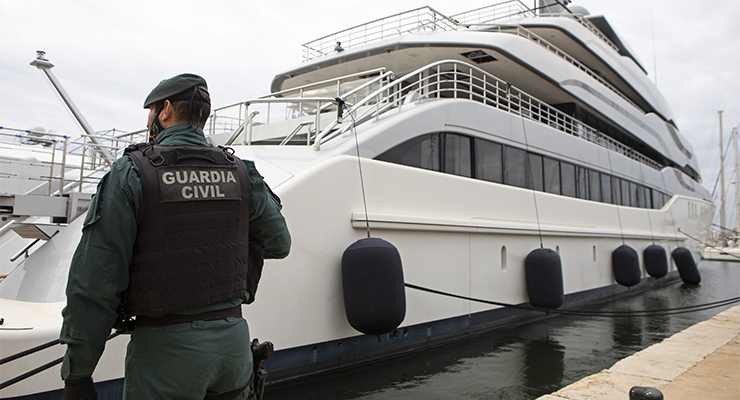
Estonia’s government has declared that it will present a “blueprint” for how frozen Russian assets can be legally seized, and lots of politicians in other countries have expressed similar ambitions. Their noble goal is to use the funds to pay for Ukraine’s reconstruction.
But seizing an asset requires an investigation linking the asset’s owner to a crime, which Italy has managed to do with some of the Russian assets it has identified, and though wealthy Russians are indisputably guilty of all manner of other sins, they have not collectively committed crimes as defined by the law.
Many of them are, of course, involved in funding the war effort, but countries wanting to seize their assets would need to prove criminality in each case. Seizing the Russians’ assets without linking them to a crime might be possible through new legislation — but it would create enormous risks for Western companies operating in other countries.
That makes wholesale seizure plans different from the seizures of assets that Italy and others have carried out — because those assets had been used in criminal ways. Indeed, seizing Russian assets without demonstrating criminality would rob Western companies and individuals abroad of the legal protection that Western governments have over the past three decades so painstakingly been prodding other governments to introduce.
EU members “need to take work forward on securing accountability for the crime of aggression and to use Russia’s frozen assets”, Estonian prime minister Kaja Kallas said last month. Her country now plans to offer a legal rationale for the expropriation of the €20 million (A$31 million) in Russian assets it has frozen.
Freezing is a favourite tool of Western governments seeking to punish another country, as it merely involves sanctioning a person or a company and, on that basis, holding their assets until the offending country changes their ways. Seizure, by contrast, means that the government permanently takes hold of them. (For a primer on the distinction, see this article.)
Unsurprisingly, seizures are common in criminal cases. Italy’s Guardia di Finanza, for example, has over the years seized enormous amounts of money and other possessions belonging to members of the mafia guilty of criminal deeds, and it has frozen impressive amounts of money, villas and yachts belonging to wealthy Russians. In cases where it could establish evidence of a crime, it has also seized Russians’ assets.
Last August, for example, the Guardia seized belongings worth €141 million euros (A$219 million) belonging to the architect of Russian President Vladimir Putin’s Black Sea palace. Lanfranco Cirillo, an Italian with Russian citizenship, will now stand trial in absentia in Italy on charges of fraud and money laundering — which are criminal offences.
But since sanctions are political designations, not criminal-justice ones, being subjected to sanctions is in itself not evidence of a crime. Seized property is typically auctioned off by the government in charge. Should you wish to buy a house seized by the US government, the US Treasury has several auctions coming up.
Little is known, so far, about the Estonian confiscation plan, apart from the fact that Estonia wants it to link up with EU plans. And the European Commission is working to find an EU-wide way of using €300 billion (A$466 billion) in frozen Russian central-bank reserves and billions more euros belonging to sanctioned Russians. “Russia must … pay financially for the devastation that it caused,” Commission president Ursula von der Leyen said in November. “The damage suffered by Ukraine is estimated at €600 billion. Russia and its oligarchs have to compensate Ukraine for the damage and cover the costs for rebuilding the country.”
There is, in fact, a lot of Russian money frozen in Western banks that could pay for the reconstruction: in addition to the US$324 billion the EU has frozen, the United Kingdom has frozen more than £18 billion (A$31.5 billion), and the United States, Switzerland and the self-governing UK Channel islands have frozen assets, too.
In total, Western allies have sanctioned more than 1200 Russian individuals, more than 120 entities, and 19 banks since Russia invaded Ukraine. That equals assets of roughly £940 billion (A$1.64 trillion). It’s an extraordinary increase from last year, when the UK, for example, held frozen Russian assets worth a mere £44.5 million (A$78 million), according to a London-based sanctions expert.
Von der Leyen’s statement is noble and a fiscally prudent one as well. Why should other countries’ taxpayers have to foot the astronomical bill for the reconstruction of a country that Russia has destroyed? Why not use funds belonging to the well-connected Russians who did nothing to stop the war? Why not take advantage of the convenient fact that it’s already sitting in Western bank accounts?
There’s the law, alas. “Under the UK’s Russia sanctions legislation, there is a low bar for designating prominent persons and companies,” said Francis Bond, a London-based lawyer with the law firm Macfarlanes who specialises in corporate crime. “The Russian government is sufficiently intertwined with the private sector that it’s often relatively straightforward to suggest that they have been, e.g., ‘obtaining a benefit from or supporting the government of Russia’.” Most other Western countries have similar legislation. Such laws make sanctioning people and freezing their assets relatively easy.
But with asset seizures, the bar is much higher. “To turn a freeze into a seize in the context of current UK legislation, you need evidence of criminality,” Bond said. “You can get that by focusing on sanctions evasion, but that will typically only allow you to seize the portion of the assets that are involved in the evasion. Given the rule-of-law constraints in this jurisdiction, the government can’t arbitrarily seize assets without persuading a court that there is evidence of criminality.”









The International Criminal Court is an independent judicial institution empowered to investigate and prosecute war crimes, crimes against humanity, genocide, and the crime of aggression. Its establishment in 2002 signaled the commitment of many countries to fight impunity for the worst international crimes. Currently, 123 countries are ICC members, giving the ICC authority, under its founding treaty, the Rome Statute, to investigate and prosecute crimes committed by their nationals or by anyone on their territory. As a matter of policy, the ICC prosecutor gives priority to cases against individuals who it determines are most responsible for the crimes under the court’s jurisdiction, regardless of their official position.
However, the United States of America is not a state party to the Rome Statute.
The US participated in the negotiations that led to the creation of the court. However, in 1998 the US was one of only seven countries – along with China, Iraq, Israel, Libya, Qatar, and Yemen – that voted against the Rome Statute. US President Bill Clinton signed the Rome Statute in 2000 but did not submit the treaty to the Senate for ratification. In 2002, President George W. Bush effectively “unsigned” the treaty, sending a note to the United Nations secretary-general that the US no longer intended to ratify the treaty and that it did not have any obligations toward it.
Should USA also be liable for repairing the damage following its illegal invasion of Iraq? Or the devastation in Vietnam and Cambodia and its wars there? Or does that not apply to a remaining super power?
You left out Afghanistan.
Assets were frozen after the carnage and invasion of Afghanistan – Afghanistan’s, for failing to submit to being invaded and smashed up. And wasn’t Vietnam frozen out financially after their failure to submit to mass murder, carpet-bombing of Hanoi and deforestation with poisons?
Let’s not forget Cuba…
Yep. Let’s also not forget the US has decided to keep Afghanistan’s US Dollar assets and use them for their own purposes.
Indeed. Brief one-line news reports at the time stated that 70% of Fallujah was destroyed by the allies in liberating the city from the terrorists. You know what 70% destruction looks like? Try Hiroshima. And wasn’t Gentleman Jim Molan in charge of that little romp?
And yet they whine continuously about Ukraine…. Do as I say, not as I do?
And channeling the great lexusaussie in another Crikey comment trail today, which facts are we being presented with? I saw no pictures of 70% destroyed Fallujah. But I notice plenty of pictures carefully taken of destruction in Ukraine, usually with huge multi-storey apartment blocks standing undamaged in the background.
Quite correct. We saw almost nothing of what happened in Iraq or Afghanistan yet we are bombarded with images of what Russia has, allegedly, done in Ukraine. Would love to see the same images of what Ukraine did in Donetsk and Luhansk over 8 years. No chance of that happening as it would spoil the narrative.
Yes, 15000 people killed in the Donbas before the Russian invasion – five times the number killed in the Sep 11 attacks in the US. Compare the subsequent publicity and outrage, compare the military responses of Russia and the US and then decide who most warrants having assets frozen.
This kind of asset seizure is purely politically motivated. Makes a mockery of the rule of law and is arbitrary power projection. The other side of the same coin is that we will never see GW Bush, John Howard and Tony Blair subjected to assets seizure for alleged war crimes.
The US AEI like their local counterpart the IPA is in Koch Network; seems to be running protection and warning about confiscating ill-gotten gains from oligarchs?
Includes western oligarchs doing business in e.g. Russia etc. and/or cooperating with suboptimal regimes?